Honeybee: The Busy Life of Apis Mellifera
 February 6th, 2020 by jules
February 6th, 2020 by jules
(Click to enlarge and see spread, including the text, in its entirety)
Bzz. Bzz. Today, I’ve got some spreads from Candace Fleming’s and Eric Rohmann’s newest book for young readers, Honeybee: The Busy Life of Apis Mellifera (Neal Porter/Holiday House, February 2020). Eric also shares some preliminary images and shows us how to un-angry a bee.
Fleming and Rohmann bring readers the journey through a life that lasts 35 days — a honeybee, who emerges from a nest before we even get to the title page spread. She grows, nurses, tends to the queen, assists in building honeycombs and storing nectar that eventually ripens into honey, guards the nest, learns to fly (on the twenty-fifth day of her life, no less) in a dramatic and exhilarating double gatefold spread, and transfers pollen. On the penultimate spread (pictured above), we witness her demise, but on the final spread, we meet a brand-new honeybee, pushing her way into life just as our protagonist did at the book’s start.
There’s so much to love about this — the solid purple endpapers; the reverence with which Fleming writes about the work of honeybees, as well as the lyricism in her prose that makes this story really sing; Rohmann’s dramatic, stunning, up-close portraits of the bee at work; and the repetition in the writing that works to great effect. (Fleming builds suspense in the book’s first half by repeatedly asking if the bee is ready to fly, with page turns that reveal it’s not quite time — that is, until we get to the exquisite double gatefold in which the bee takes off “with the sun just rising and the dew still drying.”)
In a publicity note, Fleming writes:
Action requires empathy. Kids, I realized, need to care, truly care about honeybees. Simply compiling a list of fascinating facts or presenting the grim statistics [about dwindling bee populations] would not be enough. I needed to emotionally connect young readers with honeybees — or better yet, with the life of a single honeybee. …
She certainly meets her goal here. And as the review from the Bulletin of the Center for Children’s Books notes (one of many starred reviews), both author and illustrator personalize, but never anthropomorphize, the bees. (We even learn at the book’s opening that we can call our main character “Apis” for short.) It is a remarkable moment at the book’s close, as we mourn the loss of this one bee. Appended in the book is more information about worker honeybees, including notes about what we can do about declining bee populations.
I’ll stop talking now and let some art do the talking. First, we hear from Eric. I thank him for sharing. …
Eric: This below is a first drawing. Thinned oil paint on paper. The acid-free paper is first protected by six layers of acrylic gesso and then tinted with thinned burnt umber oil paint.

Below is the first drawing of the head of Apis mellifera. I’m still attempting to get the head symmetrical, always keeping one eye on the gutter.
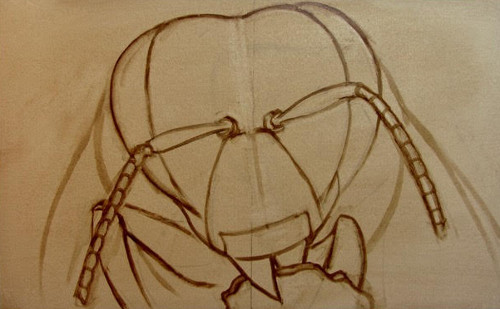
This is the neutral gray underpainting (also known as grisaille). Warm gray oil paint, applied more opaque than the burnt umber drawing underneath.

Here is an almost-completed oil painting:
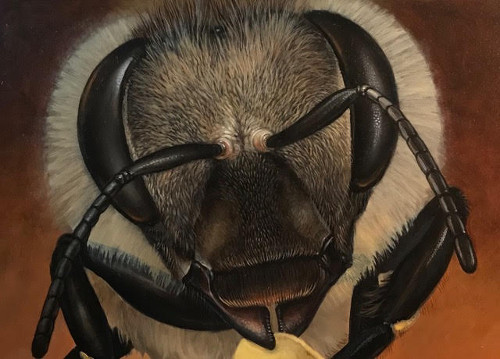
Below is the original honeybee from the cover image. There was something wrong, but I could not put my finger on it. I sent the image to a friend, just to show her what I was working on, and she suggested that the bee looked “angry.” That very day, I repainted the antennae.

Here is the final image. I changed the direction of the antennae, and Apis no longer looks like she has angry eyebrows.

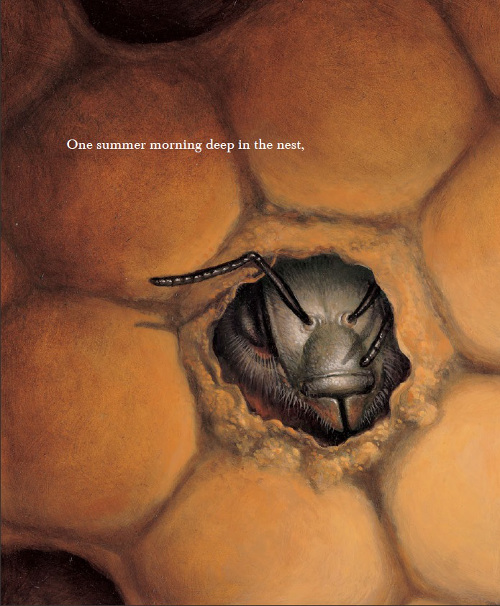

(Click spread to enlarge)

Apis flings herself at one of them. …”
(Click spread to enlarge and read text in its entirety)
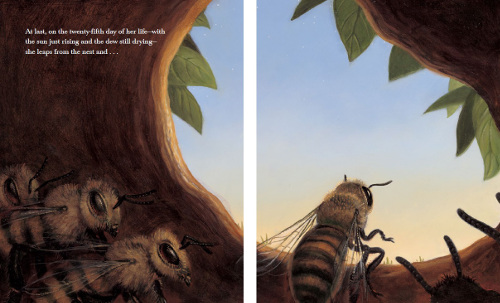
and the dew still drying—she leaps from the nest and …”
(Click spread to enlarge; this is the spread that opens into the double gatefold)

(Click this backmatter spread to enlarge and read text in its entirety)
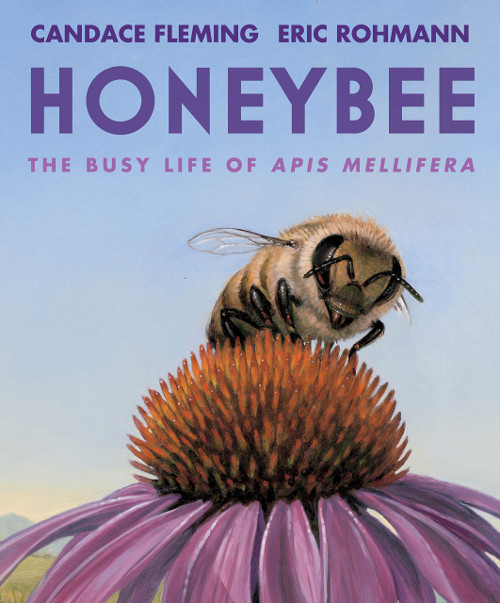
HONEYBEE: THE BUSY LIFE OF APIS MELLIFERA. Copyright © 2020 by Candace Fleming. Illustrations copyright © 2020 by Eric Rohmann and reproduced by permission of the publisher, Neal Porter Books/Holiday House, New York. All preliminary images reproduced by permission of Eric Rohmann.
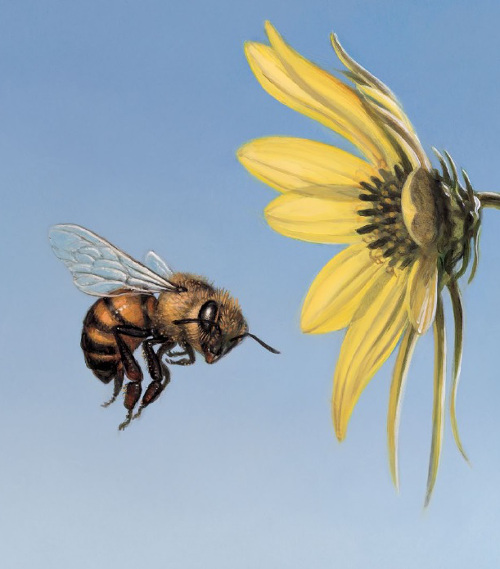

Julie,what a gorgeous review. I’m glowing! Or should I say, “abuzz” with happiness? Thank you, thank you!
Candy talked a bit about this book at a NF Retreat I attended and I’ve been eagerly awaiting this work of art (words and pictures)! She and Eric are both just brilliant!
Thank you Jules for this wonderful post and your permission to link it to my post. This books is stunning. I can’t read it without crying. Every time. You become emotionally engaged in the life of this female bee through the words and paintings. I love bees and my respect for them is strengthened with this book.
[…] Eric Rohmann’s finely detailed oil paintings in Honey Bee: The Busy Life of Apis Mellifera [http://blaine.org/sevenimpossiblethings/?p=5036], Thao Lam’s paper cuts and collage in her […]